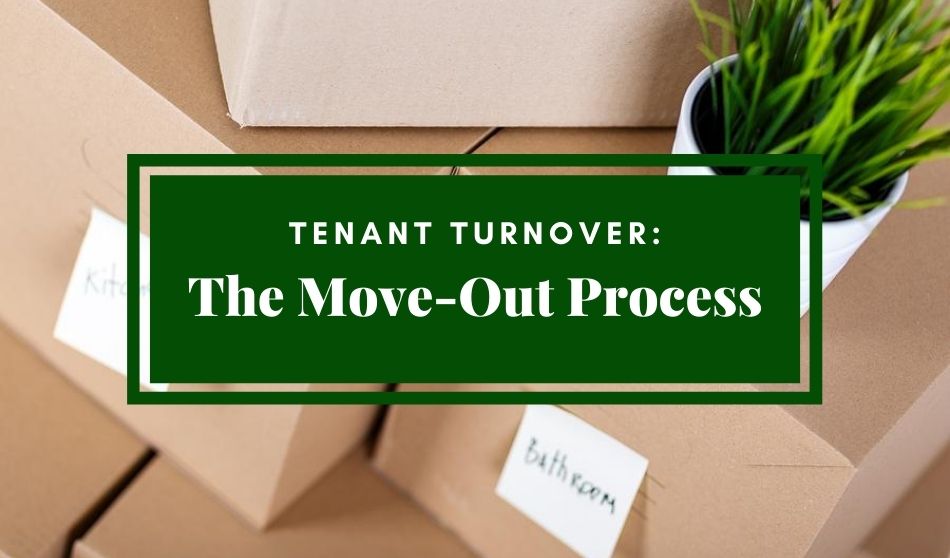
The layers of activity needed to manage the move-out process during tenant turnover can be daunting without a good system in place.
From move-out notice to final walk-through inspection to finalizing all paperwork and finances, navigating the move-out process requires a little planning for success. Having a clear map of the process can help.
When It’s Time for a Tenant to Move
No matter how good of a tenant experience you’ve created there are circumstances such as a job transfer, downsizing, and other reasons a renter might need to move. You likely will have an advanced warning if a tenant decides not to renew their lease. But oftentimes, a move-out notice can come unexpectedly, especially for those on a month-to-month agreement.
In either case, whether the notice is sent by you or received from the tenant, as soon as it has been established a move will occur start scheduling those move-out tasks to avoid time delays that cause misunderstandings and costly mistakes.
Tip: Build into your lease agreement criteria for sufficient advanced notice to help with your move-out task flow. On the flip side, be sure to reach out to your tenants well in advance of a lease renewal to get a feel for their intentions.
Schedule Upcoming Move-Outs
With all the tasks involved in a move-out, prioritizing and scheduling become vitally important.
Checklists are handy to keep it all organized. A few items to place on your checklist:
- Coordinate the pre-move out inspection
- Schedule the move-out inspection
- Calendar the move-out date
- Send a formal move-out notice acknowledgment
- Decide on the date to start advertising the vacancy
- Work with vendors to schedule the vacant rental repairs and maintenance
- Schedule the vacant rental deep-cleaning
- Decide on a date to process the move-out documents
- Process refunds or requests for payment
Unit Availability Tracking
Once you know the exact move-out date, it’s time to begin the marketing process. Before posting your upcoming vacancy, remember to review your listing, update photos, and make sure all the rental listing details are accurately noted such as contact information, new rent and deposit amounts, and any updates to your application process and approval criteria.
If you don’t know the exact availability of the unit, you can still market for interest and leads with a ‘Coming Soon’ disclaimer. That will give you time for any maintenance, repairs, carpet cleaning, or outstanding concerns which still allows you to generate leads. It also allows you to adjust the move-out date if the current tenant requests an extension.
Tenant Move-Out Statment and Deposit Refunds
Wrapping up the documentation of a tenancy is vitally important to do accurately.
In some cases, landlords collect the last month’s rent in advance. Regarding the monthly rent and any monthly charges such as utilities or pet fees, when calculating the final tenant statement you may find one of three scenarios:
- The tenant owes nothing on their account.
- There is an outstanding balance.
- The account was overpaid and the tenant is owed a refund.
In addition, the tenant may have paid deposits such as:
- Security deposit
- Cleaning deposit
- Pet deposit
- Key deposit
- Appliance rental deposit
Often these are conditionally refundable within a designated time period set by state and local regulations. If your state allows, balances owed, cleaning expenses, and repairs may be allowed to be taken from deposits received.
An itemized accounting of all items is the best practice. But before making those deductions and calculations, be sure to review those regulations for any changes regularly before withholding a deposit refund.
A Smooth Turnover
In property management, we know all the work involved in tenant turnover can be overwhelming; especially in the move-out process. How smoothly it all happens depends on great communication, organization, and efficient systems in place. Many of these tasks can be made simpler and efficiently handled with good property management software. Remember to stay in constant communication with your tenant about expectations and ways to help them make that smooth transition.
Successfully Moving Tenants Out Ensures:
- Your tenant understands their responsibilities in the move-out process.
- You get a head-start on marketing your vacancy.
- Your tenant and bank account ledgers are accurate.
- A tenant security deposit is processed correctly.
- Your active tenant list is up-to-date.
- The process runs smoothly.
In that, it’s never a bad time to start reviewing your move-out processes and evaluate the systems in place to turn a potentially daunting task into a successful routine.